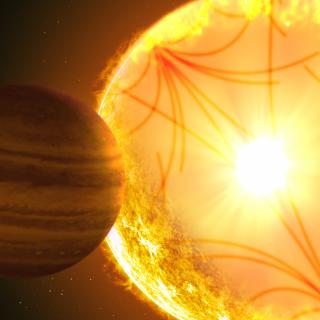Bibcode
Osborne, H. L. M.; Van Eylen, V.; Goffo, E.; Gandolfi, D.; Nowak, G.; Persson, C. M.; Livingston, J.; Weeks, A.; Pallé, E.; Luque, R.; Hellier, C.; Carleo, I.; Redfield, S.; Hirano, T.; Garbaccio Gili, M.; Alarcon, J.; Barragán, O.; Casasayas-Barris, N.; Díaz, M. R.; Esposito, M.; Knudstrup, E.; Jenkins, J. S.; Murgas, F.; Orell-Miquel, J.; Rodler, F.; Serrano, L.; Stangret, M.; Albrecht, S. H.; Alqasim, A.; Cochran, W. D.; Deeg, H. J.; Fridlund, M.; Hatzes, A. P.; Korth, J.; Lam, K. W. F.
Bibliographical reference
Monthly Notices of the Royal Astronomical Society
Advertised on:
2
2024
Citations
18
Refereed citations
16
Description
We report on the precise radial velocity follow-up of TOI-544 (HD 290498), a bright K star (V = 10.8), which hosts a small transiting planet recently discovered by the Transiting Exoplanet Survey Satellite (TESS). We collected 122 high-resolution High Accuracy Radial velocity Planet Searcher (HARPS) and HARPS-N spectra to spectroscopically confirm the transiting planet and measure its mass. The nearly 3-yr baseline of our follow-up allowed us to unveil the presence of an additional, non-transiting, longer-period companion planet. We derived a radius and mass for the inner planet, TOI-544 b, of 2.018 ± 0.076 R⊕ and 2.89 ± 0.48 M⊕, respectively, which gives a bulk density of $1.93^{+0.30}_{-0.25}$ g cm-3. TOI-544 c has a minimum mass of 21.5 ± 2.0 M⊕ and orbital period of 50.1 ± 0.2 d. The low density of planet-b implies that it has either an Earth-like rocky core with a hydrogen atmosphere, or a composition which harbours a significant fraction of water. The composition interpretation is degenerate depending on the specific choice of planet interior models used. Additionally, TOI-544 b has an orbital period of 1.55 d and equilibrium temperature of 999 ± 14 K, placing it within the predicted location of the radius valley, where few planets are expected. TOI-544 b is a top target for future atmospheric observations, for example with JWST, which would enable better constraints of the planet composition.
Related projects

Helio and Astero-Seismology and Exoplanets Search
The principal objectives of this project are: 1) to study the structure and dynamics of the solar interior, 2) to extend this study to other stars, 3) to search for extrasolar planets using photometric methods (primarily by transits of their host stars) and their characterization (using radial velocity information) and 4) the study of the planetary
Savita
Mathur

Exoplanets and Astrobiology
The search for life in the universe has been driven by recent discoveries of planets around other stars (known as exoplanets), becoming one of the most active fields in modern astrophysics. The growing number of new exoplanets discovered in recent years and the recent advance on the study of their atmospheres are not only providing new valuable
Enric
Pallé Bago